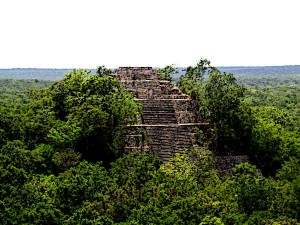Mayan Civilization came into being in Mesoamerica sometime around 500 B.C.
The Olmec Civilization, which had existed in Mesoamerican region since 2500 B.C., was a precursor to the Mayan civilization.
The Mayans borrowed many aspects of culture from the Olmecs but in a more general sense, arose independently.
The Mayans began to settle in Mesoamerica sometime before 2000 B.C.
By the second millennium B.C., the Mayan settlements were blossoming into complex societies and towns.
By 500 B.C., many of these towns had grown populous enough to turn into proper cities.
It is during this period that the Mayan civilization truly came into being.

Mesoamerica and its cultural areas
The beginning of the Mayan civilization is historically considered to have taken place in the Classic Period.
This period spans from 2000 B.C. to 250 B.C. During this period, the Mayan excellent in agriculture and began to cultivate many crops.
It was also during this period that early forms of culture such as the production of pottery began.
By the 1st millennium B.C., many Mayan cities had started coming into being.
Among the most notable Mayan cities during this period were the cities of Tikal Nakbe and El Mirador.

Typically, Mayans used agricultural produce, obsidian, different handicrafts and other items in their trade.
It was during this period that the Mayan civilization reached its apogee.
This era was marked by the rise of many densely populated Mayan cities, the establishment of different Mayan kingdoms and their mutual relations which also included the rivalry between different kingdoms.
Urban settlements were the hallmark of the Mayan civilization during this period, giving birth to many great and magnificent cities.
The Mayan cities of Tikal and Calakmul reached their glory during this period, forging extensive networks of alliances with neighboring cities in rivalry to each other.
Copan was also a very important Mayan city during this period, being a key part of the Mayan cultural and artistic development.
It was during the Classic period that some of the most remarkable monumental architecture was erected in different Mayan cities.
Other forms of artwork also became popular and were encouraged by the Mayan nobility.

One of the most stand-out features of the political system at Calakmul was the presence of many queens in the ruling dynasty
The central Mayan region which was the hub of the Classic Mayan civilization underwent rapid collapse during the 9th century A.D.
During the course of a few decades, all the great Mayan cities in the central region had been abandoned permanently and rapidly.
The populations from these areas shifted to the northern Mayan regions which then became home to a subsequent Mayan culture, not as glorious as the Classic Mayan civilization.
According to modern historians, climate changes may have been the key instigator behind such large-scale abandonment of classic Mayan cities.
This may have been coupled with attacks by non-Mayans from the outside and other factors.

View of the stonework at the Chitzen Itza Mayan ruins with fallen stone, rows of columns and the Temple of the Warriors in the background, Yucatan Peninsula, Mexico
The Mayan civilization continued to exist in one way or the other from 9th century A.D. to the arrival of Spaniards in the 16th century.
During this period, the Mayans were mostly limited to the northern regions such as the Yucatan.
Compared to the Classic Period, the Mayan civilization during this period did not see a lot of intellectual, artistic or political activity.